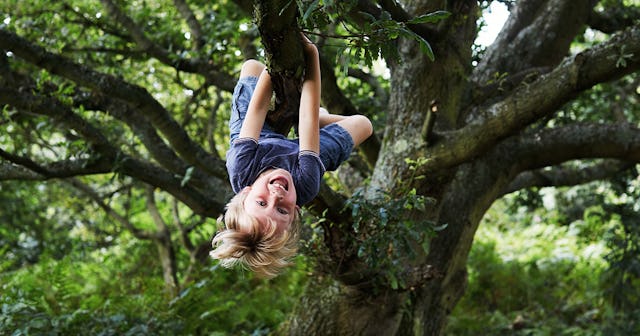Let's Bring Some Danger Back To Childhood

If you clicked on this story, then you’re probably thinking one of two things.
One—you are probably wondering what kind of nutjob they allowed to write a piece encouraging kids to be dangerous. “Does she even have kids? Is she one of those live-off-the-grid extremist?”
Or two—you are probably like “Yeah! Kids are too soft these days!”
Of course, there are also the rebels who don’t like being categorized at all. I can respect that, and I hope you’ll hear me out.
We’re building a shield around our kids, and it’s not doing them any favors.
Courtesy of Stacy Tornio
I’m seeing a generation of parents who want to save their kids from hard times, hurt feelings, and challenging situations. Many have deemed this lawnmower parenting because adults are trying to mow down obstacles before their kids have to deal themselves.
As a mom of two, I’ll admit I’ve been guilty of this from time to time. I mean, why not offer help if we can? What’s so wrong about not wanting our kids to experience pain, failure, or hurt?
This mentality shows up often in competitive sports and school. You see parents complaining about coaches, asking for special treatment, and even doing their kids homework for them.
Another big area where this regularly shows up is one I’m especially passionate about—the outdoors. To see evidence of this, all you have to do is step outside. Neighborhood streets definitely aren’t as busy as they used to be with kids enjoying unsupervised play.
And if you go to a park, and you’ll likely find highly-engaged parents who are a little too involved in their child’s play time. “Oh no, don’t do that! Here let me help you. Don’t climb on there!” (This should not be confused with parents who are just playing with their kids. This is a great thing and way better than a parent just staring at their phone the whole time.)
This overprotective, lawnmower parenting style isn’t doing our kids any favors when it comes to nature. Kids are growing up and never experiencing things like skipping rocks (you might hit someone), climbing a tree (broken arm), or looking for bugs (could be poisonous).
We seem to have a lot of rules for you should or shouldn’t do when you’re outside. And this lack of letting kids explore on their own is leading to a serious detachment to the natural world. Of course, the attachment to screen time doesn’t help much either.
We need to let kids try, fail, and take risks outside.
Courtesy of Stacy Tornio
One of the biggest ways to build a love, appreciation, and respect for something is to actually experience it. You can hear all about the awe and beauty of the ocean, but it doesn’t compare to actually being on the beach—toes in the sand—as the waves crash at your feet.
The same is true for kids, too. With so many great offerings in nature, the best thing we can do as parents is to just let them get out there and explore. And yes, this means letting kids take some risks along the way.
So as parents, how do we do this exactly? It means not thinking of the worst-case scenario with every turn. It means not always helping them figure it out when there’s a challenge. It means giving them a little freedom. And it probably means letting them experience a little bit of the childhood that we had where kids truly just went outside on their own. I definitely remember this as a kid. Granted, I grew up in the country and had lots of cousins around, but we were always being told to “go outside,” and “figure it out.”
And now the tough part comes where we let go.
Courtesy of Stacy Tornio
It’s one thing to agree we need to do this, but it’s a lot harder to put it into practice. I have adventurous kids who have been picking up snakes and climbing trees since they could walk, and it’s hard not to want to protect them when they’re outside.
So as parents, how do we let them take risks without getting too involved? We educate them.
Anytime you let kids take a few risks, there’s going to be an elevated degree of danger. However, you can greatly reduce this by making sure your kids are informed and prepared.
For example, you don’t let kids loose to gather wood and build a campfire. But you do teach them about fire safety and the eventually let them lead when they’re at the appropriate age and skill level.
The same is true for interacting with wild plants and animals. Teach your kids about dangerous animals and poisonous plants so they aren’t afraid. Then let them have a little freedom to explore wild areas on their own. Again, it’s about being age appropriate and giving them the right education around a specific topic.
Once they have the tools, though, it’s time to step back and let them have a little freedom. Yes, it’s hard. Yes, there’s a little more danger involved. But at the end of the day, I believe it will lead to a childhood that sets our kids up for future success. They’ll be able to problem solve better, cope quicker, and engage with our natural world in a much more positive way.
This article was originally published on